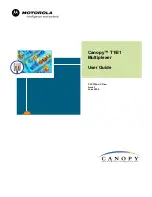
DM16E1 / DM4E1 Operation and Installation Manual - 204-4001-19
29
−
Transparent Interface Converter: Similar to Interface Converter but does not use a
scrambler in the optic aggregates. For this configuration to work properly, it is necessary
to ensure that the device connected to the optic side is transmitting data with adequate
variability to clock regeneration.
−
Regenerator: Identical to the Transparent Interface Converter. The equipment is only
used to regenerate optic signals.
−
Point to Point: Two devices are connected in a point to point topology. The chosen
tributaries are inserted in the upper order hierarchies (E2 and E3) in one end and
removed from the other one in both transmission directions. This topology allows the use
of a backup card for additional protection.
−
Regular Ring: Two or more devices are connected in a ring topology. The chosen
tributaries are inserted in the upper order hierarchies (E2 and E3) in one end and
removed from the selected devices, which may be any of the components of the ring.
The main aggregates configure one ring, and the backup aggregates configure a
protection ring to be used if the main link is lost. One or two cards per equipment may be
used. Two cards are required in backup configurations. In this topology, since data
pertinent to the main link come from one location and are redirected to another one, the
use of bidirectional aggregate cards is considered inconsistent. This configuration is
suitable to three or more devices. It should not be used in a two-device setup.
−
Cross Ring: Two or more equipment are connected in a ring topology. The chosen
tributaries are inserted in the upper order hierarchies (E2 and E3) in one end and
removed from the selected devices, which may be any of the components of the ring.
Here the pair formed by the RX of the main card and by the TX of the backup card
configures the main data link. Similarly, the pair formed by the TX of the main card and
by the RX of the backup card configures the protection data link. The main advantage of
this topology is the possibility of using bidirectional cards, hence using only one fiber link
(instead of two) between two adjacent points in the ring. As two cards are needed to
implement this configuration, the use of backup is native.
−
Line Terminator / Line Network: In-line configuration. It works similarly to the Cross Ring
topology, except for the fact that the ring ends are not interconnected. This configuration
does not allow backups. The end devices must be configured as Line Terminators, while
the remaining ones must be set to Line Network.
−
Transp. Opt.Modem / PtP Opt.Modem: Under these topologies, data received from the
aggregates are directed to an E3 tributary (DM4E1 E3 mode, and DM16E1). These may
use backups as in Point to Point topologies. Using Transp. Opt.Modem, data are
forwarded directly, with no modifications. PtP Opt.Modem allows remote device
management. The equipment will not allow these topologies when the E3 internal
tributary is not present (invalid configuration).
−
Regular Ring Opt.Modem / Cross Ring Opt.Modem: Similarly to Transp. Opt.Modem,
these topologies allow E2/E3 as tributaries in a Regular Ring or Cross Ring. As such,
access from remote locations to the data in this ring is allowed. The E2/E3 used must be
structured containing E1 tributaries according to the PDH hierarchy. All E1 channels not
used in the remote location must stay in pass-through so as to guarantee the correct
functioning of the devices connected to the ring. This configuration is suitable to three or
more devices. It should not be used in a two-device setup.
•
ALS Protection Time: Automatic Laser Shutdown control. This feature corresponds to the period
during which the laser is turned off whenever LOS is detected on the protected interface (RX in the
opposite direction, same aggregate interface except on Regular Ring and Regular Ring Opt.Modem
topologies).This protection affects only optic interfaces that are installed in the equipment. Electric
interfaces are always on. In order to disable this protection, use the value Always on.When this protection
is active, the Backup return time must be set to at least 10 seconds.
















































